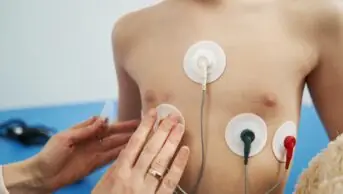
Shutterstock.com
After reading this learning article, you should be able to:
- Identify difficulties families encounter while administering medicines at home;
- Understand how these difficulties can contribute to potentially unsafe and ineffective medicines use;
- Provide advice on how to best manage these difficulties and present potential solutions to improve patient experience and outcomes.
Case 1: How medicines can cause harm at home
The safe administration of medicines within the home is an often-overlooked area of medicines use. The focus of most medicines safety initiatives has been on prescribing, dispensing and administration of medicines within healthcare settings[1]. This has resulted in a situation where relatively little is known about how medicines are administered within the family home.
When observing families administering medicines at home, researchers have estimated that around 3 in 10 medicines are not given as prescribed[2]. Interviews detailing the experiences of families administering medicines at home have identified widespread and significant problems, including unintended non-adherence, difficulty timing administration and delays in updating medication doses for administration[3,4].
By focusing on this area of medicines use, there is the potential for pharmacy and healthcare professionals to significantly improve health outcomes for families who administer medicines at home.
Case 1: How medicines can cause harm at home
Background
The patient is a boy aged two years with a tumour in his abdomen that is affecting kidney function, resulting in high blood pressure. Hydralazine has been prescribed to control blood pressure and is titrated to a dose of 6mg every six hours. The family are given an unlicensed form of hydralazine 2mg in 1mL liquid and instructed to administer 3mL at 06:00, 12:00, 18:00 and 00:00 via a nasogastric tube.
The pharmacist discusses the patient’s medicines with his parents during a hospital admission. The parents describe that the hydralazine liquid comes in a small bottle, has a short expiry date and needs to be kept in the fridge. They explain that on several occasions they have come close to missing doses as they have almost run out of medicine, and they struggle to give it every six hours.
After consultation with the pharmacist, the family choose to try a new prescription for 6.25mg four times per day. This is administered as a quarter of a 25mg tablet (using the licensed 25mg tablet formulation). The parents are shown how to quarter the tablet using a tablet cutter, and then dissolve the quarter by placing it into a syringe barrel, drawing up a small amount of water into the syringe. The tablet dissolves readily with a small amount of agitation.
The family are also supported to alter the administration times of the patient’s medicines. Instead of six-hourly administration, they decide to try administration at 8am, 1pm, 6pm and 10pm.
During routine follow-up after this change, there is no observed loss of control of the patient’s blood pressure. The family reports significant benefits from this new prescription, some of which were unanticipated. These include that the administration timings suit their routines and that the tablet formulation can be supplied in sufficient amounts to avoid parental anxiety about missing doses. It also does not require refrigerator storage.
Parent perspective
“When we had the refrigerated version of hydralazine, the cold feeling would wake him in the night; this does not happen with the tablet variant. With the tablet, we can prepare this in advance for the next morning. As I am currently sleeping in the same room, it allows me to give this to him without waking him, which is useful as he is unsettled enough.
Timing of the medication is now more conducive to ‘normal’ sleep patterns, allowing us both to sleep in more appropriate blocks, taking into account natural sleep patterns — which has had huge benefits. He is better in himself at finding his rhythm when returning from hospital.
Delivering the last dose at 10pm each day means that on a good night, we can both sleep through until 8am (notwithstanding his occasional need to go to the toilet, owing to the medication).
The more efficient grouping of medications makes planning and preparation much simpler, meaning fewer alarms and time slots to administer. This makes it much less draining for me and much more comfortable for our son, who at times struggles to be pacified, instead becoming aggravated and attempting to grab the syringe.”
Parent A
Recommendations to improve practice and patient experience
Harm from medicines can take many forms, which may lie outside what is thought to be the adverse effect profile of a medicine. This case highlights that frequent and antisocial administration times, and anxiety around using medicines, can cause harm to children and their families.
Pharmacists and healthcare professionals should work with children or young people and their families to find solutions to the problems they face by:
- Practising active listening, alongside being aware that the negative effects of a medicine may be very specific for individual patients and families;
- Following Royal Pharmaceutical Society guidance on unlicensed medicines use that encourages ongoing shared decision-making and listening to the patient experience;
- Considering simulating administration with parents to identify potential problems. This also allows healthcare professionals to fully understand what parents and carers are required to do[5].
Case 2: Balancing medicines administration and home life
Background
A girl aged five years is diagnosed with a brain tumour. Initial surgery is completed to remove the tumour, but the patient requires chemotherapy every three weeks for 18 months. Nausea and vomiting induced by the chemotherapy is a particularly traumatic side effect for the patient and her family, requiring pharmacological management.
Typically, the parents have to prepare three anti-sickness medicines for administration at home, which involve cutting two anti-sickness tablets into quarters and removing a third dispersible antihistamine tablet from a foil packet. The three tablets are then left out to be administered at a time that is convenient for the patient.
On one occasion, the family return home following an overnight stay in hospital for chemotherapy. The parent who usually takes responsibility for the medicines needs to be elsewhere, so the second parent supervises the child to take the prepared medicines. However, later in the day it is noticed that the medicines have not been taken by the child.
On investigation by the parents, two quartered tablets are found on the floor, having been misplaced owing to their small size. Despite several hours’ delay, the patient receives the other two medicines and does not suffer negative consequences.
This incident is not reported or discussed with a healthcare professional. However, the issue is highlighted when the family respond to a request from a local parent research group seeking families to talk about their experience using medicines at home.
Parent perspective
“Using medicines safely at home is difficult. Quartering an already small tablet and making it equal is tricky. I worry that doses are too high or low. These medicines are easily lost if someone is not used to giving them. Brand and generic names on packaging can be confusing, as can the type of tablets or liquid we get — for example, we have had at least three different forms of ondansetron.
Other things, such as the wrong flavour of laxative or drink supplement and wrong form of ondansetron (tablet rather than the melt), have not helped. When she hates taking these medicines already, this makes compliance worse.
I do not let anyone else look after our daughter, as I know it is just not worth the hassle or stress for them. Even when I have been in the house and asked someone to administer her medicines, problems have occurred which, luckily, I spotted.”
Parent B
Recommendations to improve practice and patient experience
This situation led to a near-miss incident that could easily arise in households where parents are splitting tablets and using different formulations.
When supporting children or young people and their families, pharmacists and healthcare professionals should:
- Use open questions such as “Have you had any problems with your medicines?” to encourage families to talk about their experiences;
- Consider how families can give feedback on safety incidents from within their home. The NHS Patient Safety Strategy provides more details about how to involve patients in improving patient safety;
- Consider using a structured consultation with families to help them to share their experiences;
- Consider the support network around parents and carers who administer medicines, and if necessary, help to train and educate other family members to administer medicines;
- Wherever possible, prescribe formulations for which patients express a preference; changing formulations may cause problems[6,7].
Case 3: Difficulties in giving an effective medicine dose
Background
A boy aged two years with a liver tumour receives cisplatin as part of his chemotherapy regimen, which is known to cause low magnesium. He also requires a nasogastric feeding tube because of the nausea, vomiting and mucositis associated with chemotherapy.
Subsequently, the patient develops hypomagnesaemia and is prescribed 2mmol enteral magnesium three times per day[8]. The administration instructions are to crush and dissolve a 4mmol tablet in 4mL, and give 2mL three times per day. Although magnesium liquid is available as an unlicensed formulation, it is not available in the hospital on this occasion.
During the patient’s next hospital admission for chemotherapy three weeks later, the doctor checks his magnesium level, which is still low, and asks for pharmacy advice. The patient’s parents explain that they find giving the medicine difficult, as the tablet does not dissolve well and they struggle to draw up the correct dose. The suspension adheres to the mixing cup and syringe and they are unsure how much medicine they are administering. In addition, preparing a medicine three times per day is time-consuming alongside the other care that their child needs.
After consultation with a pharmacist, a new dose of 4mmol twice per day is proposed. A tablet must still be dissolved in water, but it has the benefit of being easier to administer and requiring fewer administrations per day. When the parents crush and dissolve a tablet, they rinse and flush the mixing cup and syringe to ensure the whole tablet is given. Although the prescription is for twice per day, the parents can administer the magnesium throughout the day in confidence that two tablets are given by the end of the day.
During follow-up, the patient’s parents report that the new dose is much easier to administer and that they are able to do so as prescribed. The patient’s magnesium level returns to the normal range.
Parent perspective
“Administering multiple medicines every day becomes very difficult over time, when aligning them with feed cycles and our boy’s changing sleep times. It became difficult when asked to administer three times a day because the middle dose interferes with nap times.
Having to halve a tablet is an issue, but our main problem is magnesium tablets do not dissolve in water easily — 4mmol into 4mL is impossible to dissolve. This leads to residue left in the mixing cup, and the mixture often then blocks the nasogastric tube as it is dense with bits that have not dissolved. We now regularly experience low magnesium counts, for which I fear we will be responsible owing to the problems we have giving the medicine at home.”
Parent C
Recommendations to improve practice and patient experience
When supporting children or young people and their families, pharmacists and healthcare professionals should:
- Ask parents how they administer a medicine at home to understand if they can follow the instructions they have been given;
- Consider whether the literal instructions for using a medicine will best suit the needs of the patient, or whether a modification may result in a better outcome, especially as most medicines need to be modified to encourage children to take them;
- Use guidance that supports professionals to modify formulations when it is in the best interest of the patient;
- If modifying a formulation, outline a plan for how effectiveness will be checked, at what time, and which professional will take responsibility for reviewing with the family[9,10].
Reflecting and implementing learning in practice
Children are susceptible to different risks from medicines compared with adults, and these cases illustrate common issues regarding safety that families encounter when using medicines at home. Healthcare professionals should recognise that without support, patients and their families will take their own action in order to reduce the risk of harm from medicines[11]. Therefore, professionals should collaborate with families to ensure the risk of harm is minimised, and help them to ensure patients receive the maximum benefit from their medicines.
The lack of reporting of these safety incidents is preventing advancements in reducing harm from medicines used at home. To provide practical and helpful advice for families, more discovery, reporting and analysis of errors at home is needed. With greater involvement of families and their experiences, pharmacy professionals can help create and expand the evidence base around safe ways to administer medicines to children at home.
Patient consent
Parental consent was obtained on behalf of the patients described in these case studies prior to publication. The author and editors thank the parents for their contributions and for their approval of the final text prior to publication.
Financial and conflicts of interest disclosures
Stephen Morris is undertaking a National Institute for Health Research (NIHR) integrated clinical academic pre-doctoral clinical fellowship, funded by Health Education England and the NIHR.
This article was has been reviewed by the expert author to ensure it remains relevant and up to date, following its original publication in The Pharmaceutical Journal in March 2021.
- 1Sutcliffe K, Stokes G, O’Mara A et al. . Paediatric medication error: a systematic review of the extent and nature of the problem in the UK and international interventions to address it. . Evidence for Policy and Practice Information and Co-ordinating Centre. 2014.https://eppi.ioe.ac.uk/cms/Portals/0/PDF%20reviews%20and%20summaries/Paediatric%20medication%20error%202014%20Sutcliffe%20report.pdf?ver=2014-11-20-161504-377 (accessed 12 Mar 2021).
- 2Walsh KE, Roblin DW, Weingart SN, et al. Medication Errors in the Home: A Multisite Study of Children With Cancer. PEDIATRICS 2013;131:e1405–14. doi:10.1542/peds.2012-2434
- 3Aston J, Wilson KA, Terry DRP. The treatment-related experiences of parents, children and young people with regular prescribed medication. Int J Clin Pharm 2018;41:113–21. doi:10.1007/s11096-018-0756-z
- 4Doyle C. Mothers’ experiences of giving medicines to children with severe and profound intellectual disabilities—The impact on time. Child. 2022;48:558–68. doi:10.1111/cch.12960
- 5Royal Pharmaceutical Society. Prescribing Specials – Guidance for the prescribers of Specials. Royal Pharmaceutical Society. 2016.https://www.rpharms.com/Portals/0/RPS%20document%20library/Open%20access/Support/toolkit/professional-standards—prescribing-specials.pdf (accessed 12 Mar 2021).
- 6NHS England & NHS Improvement. The NHS patient safety strategy. Safer culture, safer systems, safer patients. NHS England. 2019.https://www.england.nhs.uk/patient-safety/the-nhs-patient-safety-strategy/ (accessed 12 Mar 2021).
- 7Barnett NL. Guide to undertaking person-centred inpatient (ward) outpatient (clinic) and dispensary-based pharmacy consultations. Eur J Hosp Pharm 2019;27:302–5. doi:10.1136/ejhpharm-2018-001708
- 8Paediatric Formulary Committee. BNF for Children 2020-2021. London: : London: BMJ Group, Pharmaceutical Press, and RCPCH Publications 2020. http://www.medicinescomplete.com (accessed 12 Mar 2021).
- 9van der Vossen AC, Al-Hassany L, Buljac S, et al. Manipulation of oral medication for children by parents and nurses occurs frequently and is often not supported by instructions. Acta Paediatr 2019;108:1475–81. doi:10.1111/apa.14718
- 10Alder Hey Children’s Hospital NHS Foundation Trust. Manipulation of Drugs Required in Children (MODRIC) – A Guide for Health Professionals. Alder Hey Children’s Hospital NHS Foundation Trust. 2013.https://alderhey.nhs.uk/application/files/5014/9935/2778/MODRIC-GUIDELINES.pdf (accessed 12 Mar 2021).
- 11Fylan B, Armitage G, Naylor D, et al. A qualitative study of patient involvement in medicines management after hospital discharge: an under-recognised source of systems resilience. BMJ Qual Saf 2017;27:539–46. doi:10.1136/bmjqs-2017-006813


